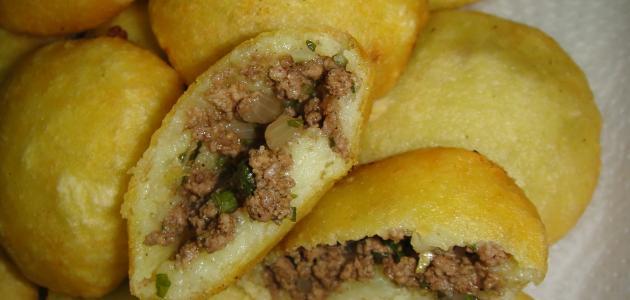Kibbeh is a very popular recipe and is considered a national dish in Lebanon, Syria and Iraq. Crispy on the outside, meaty on the inside - this golden brown treat is on to a good thing.

Soak the rice in cold water for an hour.
Wash the rice with your hands, as if you are doing the laundry, to get the starch out of it. Rinse it to clean.
Put the rice in a pot on the stove. Cover it with 3-4 inches (7.5cm - 10cm) of water. Add salt. Put it on a medium to high heat
Important: You don’t want a rapid boil, you want to cook the rice slowly and let it absorb the water. Don’t shake the rice. Don't add oil. This is not like cooking regular rice.
It will take about 10 mins for the rice to start to simmer. When it does, turn it down to a medium heat for about 15-20 mins or until it looks like the water has been absorbed.
Again, treat the rice with care, so don’t stir it, don’t mix it. It needs to stay level.
Carefully poke five little holes into the rice - use the handle end of a wooden spoon. This is to allow the remaining water at the bottom to steam up.
Turn it down for another 15 mins on a low heat. This way the rice will be very soft.
Turn off the heat, leave the pot covered and let it cool.
When the rice has cooled off enough to handle, crack one egg into it. Egg whites alone are fine (my mum uses the whole egg).
Take the mixture in your hands. Dip your hands in water to handle the dough, then knead it until it has a gummy texture and you can no longer see the individual rice grains. You want it to be slightly sticky but not so sticky that you can't work it.
Don't use a machine mixer to knead the rice as it will make it too mushy. If the dough is too hot to handle then wear rubber gloves.
Set the dough aside.
Start by sauteing the finely diced onion on a high heat.
Then add the meat, salt and pepper. Let it cook for about 5 mins.
Chop the parsley, lower the heat to medium, then add the parsley.
Sautee until the liquid from the meat has been absorbed. This shouldn't take take very long: around 20-30 mins if you are cooking on medium.
If there is excess fat, just tip the pan, move the qeema aside and pat dry with a napkin.
Ensure the meat does not burn: keep stirring until it feels cooked and starts to brown.
Ensure you have the bowl of rice dough, the pot of qeema and some water for your hands nearby.
Dip your hands in water and take some dough. Working the dough with your hands, make a ball about the size of a small egg.
Make a well in the dough with your index finger. Then flatten out the sides of the well (see above). Try to make it about espresso cup size.
Add about a tbsp or less of qeema with one hand, then close the ball with the other hand.
Then cup the ball with your hands to make it into an egg shape, ensuring you keep your hands slightly wet.
Make as many as you want before you start frying.
Deep fry until they are golden, ensuring that they are covered in oil. Fry as many as you want at a time, without crowding the pot.
Let them dry on a cooling rack, then serve
Ingredients
Directions
Soak the rice in cold water for an hour.
Wash the rice with your hands, as if you are doing the laundry, to get the starch out of it. Rinse it to clean.
Put the rice in a pot on the stove. Cover it with 3-4 inches (7.5cm - 10cm) of water. Add salt. Put it on a medium to high heat
Important: You don’t want a rapid boil, you want to cook the rice slowly and let it absorb the water. Don’t shake the rice. Don't add oil. This is not like cooking regular rice.
It will take about 10 mins for the rice to start to simmer. When it does, turn it down to a medium heat for about 15-20 mins or until it looks like the water has been absorbed.
Again, treat the rice with care, so don’t stir it, don’t mix it. It needs to stay level.
Carefully poke five little holes into the rice - use the handle end of a wooden spoon. This is to allow the remaining water at the bottom to steam up.
Turn it down for another 15 mins on a low heat. This way the rice will be very soft.
Turn off the heat, leave the pot covered and let it cool.
When the rice has cooled off enough to handle, crack one egg into it. Egg whites alone are fine (my mum uses the whole egg).
Take the mixture in your hands. Dip your hands in water to handle the dough, then knead it until it has a gummy texture and you can no longer see the individual rice grains. You want it to be slightly sticky but not so sticky that you can't work it.
Don't use a machine mixer to knead the rice as it will make it too mushy. If the dough is too hot to handle then wear rubber gloves.
Set the dough aside.
Start by sauteing the finely diced onion on a high heat.
Then add the meat, salt and pepper. Let it cook for about 5 mins.
Chop the parsley, lower the heat to medium, then add the parsley.
Sautee until the liquid from the meat has been absorbed. This shouldn't take take very long: around 20-30 mins if you are cooking on medium.
If there is excess fat, just tip the pan, move the qeema aside and pat dry with a napkin.
Ensure the meat does not burn: keep stirring until it feels cooked and starts to brown.
Ensure you have the bowl of rice dough, the pot of qeema and some water for your hands nearby.
Dip your hands in water and take some dough. Working the dough with your hands, make a ball about the size of a small egg.
Make a well in the dough with your index finger. Then flatten out the sides of the well (see above). Try to make it about espresso cup size.
Add about a tbsp or less of qeema with one hand, then close the ball with the other hand.
Then cup the ball with your hands to make it into an egg shape, ensuring you keep your hands slightly wet.
Make as many as you want before you start frying.
Deep fry until they are golden, ensuring that they are covered in oil. Fry as many as you want at a time, without crowding the pot.
Let them dry on a cooling rack, then serve

